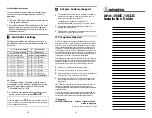
Configuring the switch
189
Common Internal Spanning Tree Port Configuration
To display the following form, go to the Ports Common Internal Spanning Tree Configuration form. Select
a CIST Port number.
This form summarizes the port CIST parameters. Common Internal Spanning Tree port parameters are
used to modify MSTP operation on an individual port basis. For each port, MSTP is turned on by default.
The following table describes the Common Internal Spanning Tree Port Configuration controls:
Table 123
Common Internal Spanning Tree Port Configuration controls
Control Description
Port Priority (0-240)
Configures the CIST port priority. The port priority helps determine which bridge port
becomes the designated port. In a network topology that has multiple bridge ports
connected to a single segment, the port with the lowest port priority becomes the
designated port for the segment.
The range is 0 to 240, in steps of 16 (0, 16, 32...) and the default is 128.
Path Cost (1-200000000) Configures the CIST port path cost. The port path cost is used to help determine the
designated port for a segment. Generally speaking, the faster the port, the lower the
path cost.
The default value for Gigabit ports is 20000, and for 10Gb ports is 2000.
Link Type
Defines the type of link connected to the port, as follows:
•
auto: Configures the port to detect the link type, and automatically match its
settings.
•
p2p: Configures the port for Point-To-Point protocol.
•
shared: Configures the port to connect to a shared medium (usually a hub).
The default link type is auto.
Enable/Disable Edge
Enables or disables this port as an edge port. An edge port is not connected to a
bridge, and can begin forwarding traffic as soon as the link is up. Configure server
ports as edge ports (enabled). This command is disabled by default.
Port STP State
Turns MSTP on or off for this port.
















































